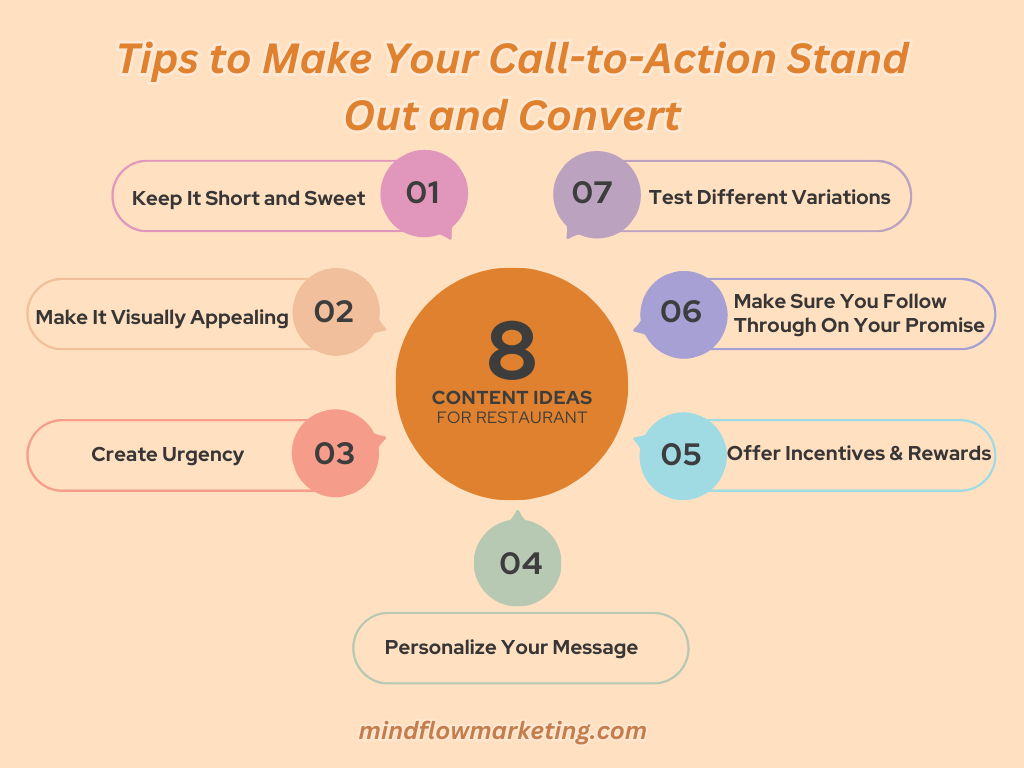Are you looking to make your call-to-action stand out and convert? These essential tips for increased conversions will take your call to action to the next level.
From defining goals, crafting engaging messages, and choosing the right placement and design – to leveraging social proof, utilizing A/B testing techniques, and analyzing results – these tips will help ensure that every click counts.
Take advantage of this opportunity to increase conversions by optimizing your calls-to-action today.

More Resources :
What is a CTA?
A call to action (CTA) is a statement or command encouraging your audience to take immediate action. It’s pivotal when you ask your readers, viewers, and followers to do something specific with what they’ve just learned from you. When used correctly, CTAs can effectively drive conversions and boost sales. They should be concise, clear, direct, and, most importantly – persuasive.
Tips to Make Your Call-to-Action Stand Out and Convert !

When crafting your call-to-action, make sure to keep it short and sweet. Longer calls-to-action can confuse or intimidate the reader, so try to limit yourself to a few words that get the point across quickly and effectively. For example, instead of “Click here now to learn more about our services,” you could say, “Learn More Now!”
Use colors, fonts, and other design elements to make your call-to-action stand out from the rest of your content. This will draw attention to it and help encourage people to take action on what you are asking them to do.
People often need an extra push to take action on something they might otherwise ignore or forget about later on. Creating urgency by adding phrases like “now” or “today only” can give readers that extra nudge they need to act immediately instead of putting it off until they may have forgotten all about it!
People respond better when things feel personal, even if they aren’t personalized just for them specifically! Try using language such as “you” or “your” throughout your call-to-action message to create a sense of connection with potential customers who are reading it. This will increase their likelihood of acting on what you’re asking them to!
Offering incentives such as discounts or rewards is another great way to encourage people to take action immediately rather than waiting until later (or never). Even small rewards like free shipping can motivate someone to make a purchase sooner rather than later, especially if there’s an expiration date attached which creates additional urgency!
If you promise something within your call-to-action message, ensure that whatever reward incentive promises is delivered once someone takes the desired action (i..e clicks through, etc.). Nothing turns off potential customers faster than feeling duped after clicking through expecting one thing. However, getting something completely different and not following through with promises made within CTA messages can damage trust between businesses & consumers quickly, so always ensure whatever was promised is delivered accordingly!
Finally, don’t be afraid to test different variations of CTAs against each other to see which one performs best overall. A B testing is essential when trying to optimize conversion rates & clickthroughs, so feel free to experiment with various phrasing & designs until you find one that works best!
Measure and Optimize Performance
Measure and Optimizing performance are integral elements of any victorious regional advertising initiative. To ensure that your efforts are paying off, you need to constantly monitor the results of your campaigns and adjust strategies accordingly. A successful CTA should be crafted to captivate your intended audience and spur them into taking the desired action. Creative calls, such as emails or common calls, can entice people to engage with your content. Additionally, action buttons on landing pages can help direct users towards desired actions like signing up for newsletters or downloading resources.

Once you have established a CTA strategy, it is time to measure its success over time by tracking metrics such as clicks, conversions, page visits, etc. Analyzing tools such as Google Analytics can provide valuable insights into how well each CTA performs in reach and engagement levels so that adjustments can be made if needed. It is also important to consider the placement and design elements when testing CTAs; make sure they are visible yet not intrusive while utilizing color psychology and contrasts effectively for maximum impact.
Leverage Social Proof and Reviews
Leveraging social proof and reviews is a great way to establish credibility with potential customers. User-generated content (UGC) can help build trust by providing an unbiased look at your product or service from real people who have used it. Highlighting positive experiences that customers have had with your business will show potential customers that you are reliable and trustworthy.
Incorporating UGC into your marketing efforts is easy, as many platforms are available for businesses to utilize, such as customer review sites, blogs, forums, and social media networks like Facebook or Twitter. Video endorsements from content purchasers can likewise be utilized further to show the worth of your item or administration. By showcasing these types of reviews on your website or in other digital marketing materials, you can quickly create a sense of confidence among prospective buyers about the quality of your offer.
Highlighting positive experiences with customer reviews is key to creating a sense of confidence among prospective buyers. To encourage action, use actionable language in your reviews, such as “call now” or “click here” buttons, instead of generic phrases like “great experience.”
Utilize A/B Testing
A/B testing is a powerful tool for optimizing local marketing campaigns. A/B testing allows marketers to examine contrasting versions of their CTA and establish which one brings about the most desirable outcomes. A/B testing can be used to assess the efficacy of various CTAs, helping businesses recognize which approaches are most successful in terms of conversion rate, user interaction, and return on investment.
Once you have a clear objective, it’s time to design your experiment by creating two versions of the CTA – one as the control and another representing the variable being tested. This could be anything from increasing website traffic to boosting lead generation or improving customer satisfaction.
When designing your experiment, ensure both versions of the CTA are visually appealing enough to stand out on any page they’re featured on. Once you’ve designed your two CTA variations, it’s time to launch the test. Monitor results over time and adjust strategies based on performance metrics such as clickthrough rates (CTR), conversion rates (CVR), and bounce rates. If one version outperforms the other, use this data going forward when crafting future CTAs – remember, knowledge is power.
Analyze the Results
Analyzing the results of any local marketing campaign is essential to understanding its effectiveness and refining strategies for maximum impact. Tracking conversions and ROI are key metrics in determining success and identifying areas that need improvement. To accurately measure performance, tracking website visits, impressions, clicks, leads generated, cost per click (CPC), cost per acquisition (CPA), and other relevant data points over time is important. This will provide valuable insights into your campaigns’ effectiveness at reaching target audiences and driving desired outcomes.
Analyzing the results of any local marketing campaign is essential to understanding its effectiveness and refining strategies for maximum impact. Tracking conversions and ROI are key metrics in determining success and identifying areas that need improvement. To accurately measure performance, tracking website visits, impressions, clicks, leads generated, cost per click (CPC), cost per acquisition (CPA), and other relevant data points over time is important. This will provide valuable insights into your campaigns’ effectiveness at reaching target audiences and driving desired outcomes.
It is also important to refine strategies based on the analysis of these results. For example, suppose you find that a particular CTA isn’t generating many clicks or conversions. In that case, consider adjusting the language used or making changes to the ad’s design. If you identify that certain keywords are not delivering desired outcomes, it may be beneficial to modify your keyword approach. Small tweaks like this can have a big impact on overall performance so it pays off to take some time to analyze each element of your campaigns before moving forward with any major decisions or changes.
FAQs about Tips for a Killer Call-To-action
Conclusion
Creating a killer call-to-action can help your business stand out and increase conversions. To ensure success, it’s important to define your goal, craft an engaging message, choose the right placement and design for maximum visibility, leverage social proof and reviews, test different variations with A/B testing methods, and analyze results to optimize performance. By following these tips for a killer call-to-action, you’ll be able to drive more leads, ultimately resulting in increased sales.
Take control of your local marketing with OptiLocal‘s suite of services! Get the results you want and need today by optimizing your website, improving SEO, creating engaging content, and managing your online reputation.